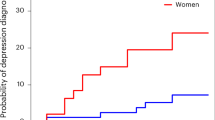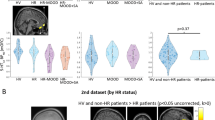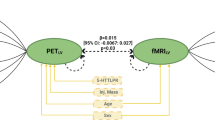Abstract
Life stress is a robust risk factor for later development of mood disorders, particularly for individuals at familial risk. Likewise, scoring high on the personality trait neuroticism is associated with an increased risk for mood disorders. Neuroticism partly reflects stress vulnerability and is positively correlated to frontolimbic serotonin 2A (5-HT2A) receptor binding. Here, we investigate whether neuroticism interacts with familial risk in relation to frontolimbic 5-HT2A receptor binding. Twenty-one healthy twins with a co-twin history of mood disorder and 16 healthy twins without a co-twin history of mood disorder were included. They answered self-report personality questionnaires and underwent [18F]altanserin positron emission tomography. We found a significant interaction between neuroticism and familial risk in predicting the frontolimbic 5-HT2A receptor binding (p=0.026) in an analysis adjusting for age and body mass index. Within the high-risk group only, neuroticism and frontolimbic 5-HT2A receptor binding was positively associated (p=0.0037). In conclusion, our data indicate that familial risk and neuroticism interact in their relation to frontolimbic 5-HT2A receptor binding. These findings point at a plausible neurobiological link between genetic and personality risk factors and vulnerability to developing mood disorders. It contributes to our understanding of why some people at high risk develop mood disorders while others do not. We speculate that an increased stress reactivity in individuals at high familial risk for mood disorders might enhance the effect of neuroticism in shaping the impact of potential environmental stress and thereby influence serotonergic neurotransmission.
Similar content being viewed by others
Log in or create a free account to read this content
Gain free access to this article, as well as selected content from this journal and more on nature.com
or
References
Adams KH, Pinborg LH, Svarer C, Hasselbalch SG, Holm S, Haugbol S et al (2004). A database of [(18)F]-altanserin binding to 5-HT(2A) receptors in normal volunteers: normative data and relationship to physiological and demographic variables. Neuroimage 21: 1105–1113.
Akiskal HS, Benazzi F (2006). The DSM-IV and ICD-10 categories of recurrent [major] depressive and bipolar II disorders: evidence that they lie on a dimensional spectrum. J Affect Disord 92: 45–54.
Attar-Levy D, Martinot JL, Blin J, Dao-Castellana MH, Crouzel C, Mazoyer B et al (1999). The cortical serotonin2 receptors studied with positron-emission tomography and [18F]-setoperone during depressive illness and antidepressant treatment with clomipramine. Biol Psychiatry 45: 180–186.
Barr CS, Newman TK, Schwandt M, Shannon C, Dvoskin RL, Lindell SG et al (2004a). Sexual dichotomy of an interaction between early adversity and the serotonin transporter gene promoter variant in rhesus macaques. Proc Natl Acad Sci USA 101: 12358–12363.
Barr CS, Newman TK, Shannon C, Parker C, Dvoskin RL, Becker ML et al (2004b). Rearing condition and rh5-HTTLPR interact to influence limbic-hypothalamic-pituitary-adrenal axis response to stress in infant macaques. Biol Psychiatry 55: 733–738.
Berton O, Aguerre S, Sarrieau A, Mormede P, Chaouloff F (1998). Differential effects of social stress on central serotonergic activity and emotional reactivity in Lewis and spontaneously hypertensive rats. Neuroscience 82: 147–159.
Bhagwagar Z, Hinz R, Taylor M, Fancy S, Cowen P, Grasby P (2006). Increased 5-HT(2A) receptor binding in euthymic, medication-free patients recovered from depression: a positron emission study with [(11)C]MDL 100,907. Am J Psychiatry 163: 1580–1587.
Biver F, Wikler D, Lotstra F, Damhaut P, Goldman S, Mendlewicz J (1997). Serotonin 5-HT2 receptor imaging in major depression: focal changes in orbito-insular cortex. Br J Psychiatry 171: 444–448.
Brummett BH, Boyle SH, Siegler IC, Kuhn CM, Ashley-Koch A, Jonassaint CR et al (2007). Effects of Environmental Stress and Gender on Associations among symptoms of depression and the serotonin transporter gene linked polymorphic region (5-HTTLPR). Behav Genet 38: 34–43.
Cahir M, Ardis T, Reynolds GP, Cooper SJ (2007). Acute and chronic tryptophan depletion differentially regulate central 5-HT1A and 5-HT 2A receptor binding in the rat. Psychopharmacology (Berl) 190: 497–506.
Caspi A, Sugden K, Moffitt TE, Taylor A, Craig IW, Harrington H et al (2003). Influence of life stress on depression: moderation by a polymorphism in the 5-HTT gene. Science 301: 386–389.
Christensen MV, Kyvik KO, Kessing LV (2007). Subclinical psychopathology and socio-economic status in unaffected twins discordant for affective disorder. J Psychiatr Res 41: 229–238.
Dwivedi Y, Mondal AC, Payappagoudar GV, Rizavi HS (2005). Differential regulation of serotonin (5HT)2A receptor mRNA and protein levels after single and repeated stress in rat brain: role in learned helplessness behavior. Neuropharmacology 48: 204–214.
Erritzoe D, Frokjaer VG, Haugbol S, Marner L, Svarer C, Holst K et al (2009). Brain serotonin 2A receptor binding: relations to body mass index, tobacco and alcohol use. Neuroimage 46: 23–30.
Fanous A, Gardner CO, Prescott CA, Cancro R, Kendler KS (2002). Neuroticism, major depression and gender: a population-based twin study. Psychol Med 32: 719–728.
Fanous AH, Neale MC, Aggen SH, Kendler KS (2007). A longitudinal study of personality and major depression in a population-based sample of male twins. Psychol Med 37: 1163–1172.
Frokjaer VG, Mortensen EL, Nielsen FA, Haugbol S, Pinborg LH, Adams KH et al (2008). Frontolimbic serotonin 2A receptor binding in healthy subjects is associated with personality risk factors for affective disorder. Biol Psychiatry 63: 569–576.
Gaspar P, Cases O, Maroteaux L (2003). The developmental role of serotonin: news from mouse molecular genetics. Nat Rev Neurosci 4: 1002–1012.
Gotlib IH, Joormann J, Minor KL, Hallmayer J (2008). HPA axis reactivity: a mechanism underlying the associations among 5-HTTLPR, stress, and depression. Biol Psychiatry 63: 847–851.
Gunther L, Liebscher S, Jahkel M, Oehler J (2008). Effects of chronic citalopram treatment on 5-HT1A and 5-HT2A receptors in group- and isolation-housed mice. Eur J Pharmacol 593: 49–61.
Hasin DS, Goodwin RD, Stinson FS, Grant BF (2005). Epidemiology of major depressive disorder: results from the national epidemiologic survey on alcoholism and related conditions. Arch Gen Psychiatry 62: 1097–1106.
Heal DJ, Philpot J, Molyneux SG, Metz A (1985). Intracerebroventricular administration of 5,7-dihydroxytryptamine to mice increases both head-twitch response and the number of cortical 5-HT2 receptors. Neuropharmacology 24: 1201–1205.
Jacobs N, Kenis G, Peeters F, Derom C, Vlietinck R, van Os J (2006). Stress-related negative affectivity and genetically altered serotonin transporter function: evidence of synergism in shaping risk of depression. Arch Gen Psychiatry 63: 989–996.
Kajantie E (2006). Fetal origins of stress-related adult disease. Ann NY Acad Sci 1083: 11–27.
Kendler KS, Gatz M, Gardner CO, Pedersen NL (2006a). A Swedish national twin study of lifetime major depression. Am J Psychiatry 163: 109–114.
Kendler KS, Gatz M, Gardner CO, Pedersen NL (2006b). Personality and major depression: a Swedish longitudinal, population-based twin study. Arch Gen Psychiatry 63: 1113–1120.
Kendler KS, Kessler RC, Walters EE, MacLean C, Neale MC, Heath AC et al (1995). Stressful life events, genetic liability, and onset of an episode of major depression in women. Am J Psychiatry 152: 833–842.
Kendler KS, Neale MC, Kessler RC, Heath AC, Eaves LJ (1993a). A longitudinal twin study of personality and major depression in women. Arch Gen Psychiatry 50: 853–862.
Kendler KS, Neale MC, MacLean CJ, Heath AC, Eaves LJ, Kessler RC (1993b). Smoking and major depression. A causal analysis. Arch Gen Psychiatry 50: 36–43.
Kendler KS, Pedersen NL, Farahmand BY, Persson PG (1996). The treated incidence of psychotic and affective illness in twins compared with population expectation: a study in the Swedish Twin and Psychiatric Registries. Psychol Med 26: 1135–1144.
Kutcher S, Marton P (1991). Affective disorders in first-degree relatives of adolescent onset bipolars, unipolars, and normal controls. J Am Acad Child Adolesc Psychiatry 30: 75–78.
Levinson DF (2006). The genetics of depression: a review. Biol Psychiatry 60: 84–92.
Mannie ZN, Harmer CJ, Cowen PJ (2007). Increased waking salivary cortisol levels in young people at familial risk of depression. Am J Psychiatry 164: 617–621.
Messa C, Colombo C, Moresco RM, Gobbo C, Galli L, Lucignani G et al (2003). 5-HT(2A) receptor binding is reduced in drug-naive and unchanged in SSRI-responder depressed patients compared to healthy controls: a PET study. Psychopharmacology (Berl) 167: 72–78.
Meyer JH, Kapur S, Eisfeld B, Brown GM, Houle S, DaSilva J et al (2001). The effect of paroxetine on 5-HT(2A) receptors in depression: an [(18)F]setoperone PET imaging study. Am J Psychiatry 158: 78–85.
Meyer JH, McMain S, Kennedy SH, Korman L, Brown GM, DaSilva JN et al (2003). Dysfunctional attitudes and 5-HT2 receptors during depression and self-harm. Am J Psychiatry 160: 90–99.
Modell S, Lauer CJ, Schreiber W, Huber J, Krieg JC, Holsboer F (1998). Hormonal response pattern in the combined DEX-CRH test is stable over time in subjects at high familial risk for affective disorders. Neuropsychopharmacology 18: 253–262.
Moffitt TE, Caspi A, Rutter M (2005). Strategy for investigating interactions between measured genes and measured environments. Arch Gen Psychiatry 62: 473–481.
Mormede P, Courvoisier H, Ramos A, Marissal-Arvy N, Ousova O, Desautes C et al (2002). Molecular genetic approaches to investigate individual variations in behavioral and neuroendocrine stress responses. Psychoneuroendocrinology 27: 563–583.
Müller-Gärtner HW, Links JM, Prince JL, Bryan RN, McVeigh E, Leal JP et al (1992). Measurement of radiotracer concentration in brain gray matter using positron emission tomography: MRI-based correction for partial volume effects. J Cereb Blood Flow Metab 12: 571–583.
Pinborg LH, Adams KH, Svarer C, Holm S, Hasselbalch SG, Haugbol S et al (2003). Quantification of 5-HT2A receptors in the human brain using [18F]altanserin-PET and the bolus/infusion approach. J Cereb Blood Flow Metab 23: 985–996.
Pini S, de Queiroz V, Pagnin D, Pezawas L, Angst J, Cassano GB et al (2005). Prevalence and burden of bipolar disorders in European countries. Eur Neuropsychopharmacol 15: 425–434.
Portella MJ, Harmer CJ, Flint J, Cowen P, Goodwin GM (2005). Enhanced early morning salivary cortisol in neuroticism. Am J Psychiatry 162: 807–809.
Quarantelli M, Berkouk K, Prinster A, Landeau B, Svarer C, Balkay L et al (2004). Integrated software for the analysis of brain PET/SPECT studies with partial-volume-effect correction. J Nucl Med 45: 192–201.
Skovdahl-Hansen H, Mortensen EL, Scioetz HK (2004). Dokumentation for den danske udgave af NEO PI-R og NEO PI-R Kort Version. Dansk psykologisk forlag: Copenhagen, Denmark.
Stockmeier CA (2003). Involvement of serotonin in depression: evidence from postmortem and imaging studies of serotonin receptors and the serotonin transporter. J Psychiatr Res 37: 357–373.
Svarer C, Madsen K, Hasselbalch SG, Pinborg LH, Haugbol S, Frokjaer VG et al (2005). MR-based automatic delineation of volumes of interest in human brain PET images using probability maps. Neuroimage 24: 969–979.
Talge NM, Neal C, Glover V (2007). Antenatal maternal stress and long-term effects on child neurodevelopment: how and why? J Child Psychol Psychiatry 48: 245–261.
Trajkovska V, Kirkegaard L, Krey G, Marcussen AB, Thomsen MS, Chourbaji S et al (2009). Activation of glucocorticoid receptors increases 5-HT2A receptor levels. Exp Neurol 218: 83–91.
Uher R, McGuffin P (2008). The moderation by the serotonin transporter gene of environmental adversity in the aetiology of mental illness: review and methodological analysis. Mol Psychiatry 13: 131–146.
Vinberg M, Mortensen EL, Kyvik KO, Kessing LV (2007). Personality traits in unaffected twins discordant for affective disorder. Acta Psychiatr Scand 115: 442–450.
Woods RP, Cherry SR, Mazziotta JC (1992). Rapid automated algorithm for aligning and reslicing PET images. J Comput Assist Tomogr 16: 620–633.
Yatham LN, Liddle PF, Shiah IS, Scarrow G, Lam RW, Adam MJ et al (2000). Brain serotonin2 receptors in major depression: a positron emission tomography study. Arch Gen Psychiatry 57: 850–858.
Acknowledgements
We are grateful to the participants. We thank Karin Stahr, Dorthe Givard, and the staff at the PET centre, Rigshospitalet for their superb technical assistance. Thanks to the Department of Psychiatric Demography, University of Aarhus, Psychiatric Hospital, Riskov, Denmark, and to the Danish Twin Registry for cooperation in the study. The John and Birthe Meyer Foundation is thanked for the donation of the Cyclotron and PET scanner. This work was generously supported by Danish Medical Research Council, The Health Science Faculty, University of Copenhagen, the 1991 Pharmacy Foundation, The Lundbeck Foundation, the EU Sixth framework programme (EC-FP6-project DiMI (LSHB-CT-2005-512146)), Sawmill owner Jeppe Juhl and Wife Ovita Juhls Foundation, ‘Laegernes forsikringsforening af 1891,’ and ‘Fonden af 1870.’
Author information
Authors and Affiliations
Corresponding author
Ethics declarations
Competing interests
The authors declare that, except for income received from their primary employers, no financial support or compensation has been received from any individual or corporate entity over the past three years for research or professional service and there are no personal financial holdings that could be perceived as constituting a potential conflict of interest.
Rights and permissions
About this article
Cite this article
Frokjaer, V., Vinberg, M., Erritzoe, D. et al. Familial Risk for Mood Disorder and the Personality Risk Factor, Neuroticism, Interact in Their Association with Frontolimbic Serotonin 2A Receptor Binding. Neuropsychopharmacol 35, 1129–1137 (2010). https://doi.org/10.1038/npp.2009.218
Received:
Revised:
Accepted:
Published:
Issue date:
DOI: https://doi.org/10.1038/npp.2009.218
Keywords
This article is cited by
-
Neuroticism predicts the impact of serotonin challenges on fear processing in subgenual anterior cingulate cortex
Scientific Reports (2018)
-
Regulating Prefrontal Cortex Activation: An Emerging Role for the 5-HT2A Serotonin Receptor in the Modulation of Emotion-Based Actions?
Molecular Neurobiology (2013)
-
The Development, Past Achievements, and Future Directions of Brain PET
Journal of Cerebral Blood Flow & Metabolism (2012)
-
Cerebral 5-HT2A Receptor and Serotonin Transporter Binding in Humans Are Not Affected by the val66met BDNF Polymorphism Status or Blood BDNF Levels
Journal of Cerebral Blood Flow & Metabolism (2010)



